Texas sits in a sweet spot near the Pacific Ocean, the western desert interior of North America, and the eastern half of the country. That means it gets to see hundreds of species of different birds. Some live there all year long, while others visit the state as they migrate on through.
When it comes to owls, Texas is home to 13 different species, of few of which can’t be seen in the rest of the US. If you want to see the Ferruginous Pygmy Owl, you have to come to rural southern Texas. Then again, if you live in Austin, Houston, San Antonio, or Dallas, you still have plenty of options to see owls like the Great Horned Owl.
If you’re a serious bird watcher, head to Sam Houston National Forest, Calhoun County, Brownsville, or Big Bend National Park. All of these areas are well-known as hotspots for birdwatching. You’re sure to see at least one species, if not more.
Here is the list of owls in Texas:
- Ferruginous Pygmy Owl
- Elf Owl
- Great Horned Owl
- Barred Owl
- Short-Eared Owl
- Northern Saw-Whet Owl
- Burrowing Owl
- Long-Eared Owl
- Eastern Screech Owl
- Western Screech Owl
- Flammulated Owl
- Barn Owl
- Spotted Owl
13 Types of Owls in Texas
1. Ferruginous Pygmy Owl
- Scientific name: Glaucidium brasilianum
- Size: 5.9 inches long
- Weight: 2.5 ounces
- Wingspan: 14.5-16.0 inches
Most of the United States misses out on seeing the beautiful Ferruginous Pygmy Owl. That’s because it only lives in southern Arizona and Texas. Even in those areas, it is extremely rare. It lives in mesquite trees and saguaros.
Because this is such an uncommon bird, we don’t know a whole lot about it. We know that it likes to hunt at dawn or dusk and that it’s very aggressive for such a small bird. You might even see it pop out during the day to hunt, when it will take down other small birds.
In retaliation, if songbirds hear the ferruginous pygmy owl calling, they will mob and harass it to get it out of their area.
They’re dark brown with white stripes and cinnamon markings, along with a streaked crown. The eyes and beak are yellow.
2. Elf Owl
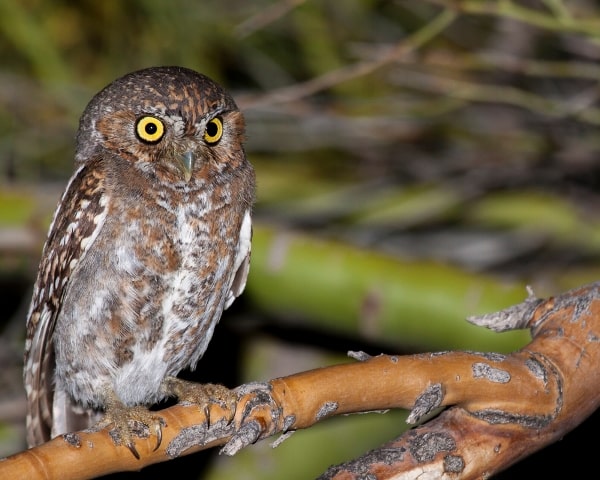
- Scientific name: Micrathene whitneyi
- Size: 4.7-5.5 inches long
- Weight: 1.2-1.9 ounces
- Wingspan: 13.0 inches
Say “hello” to the smallest raptor in the entire world. These desert-loving birds spend some of their time in Arizona, New Mexico, Texas, and Mexico. You will only see them on the western part of the state during the breeding season.
They’re smaller than a robin and use their size to their advantage, taking over small cavities in trees left by woodpeckers and other critters. They hunt at night, looking for insects to eat.
While they’re easily recognized by their puppy-like calls, if you happen to see one, you can probably identify it just by its size. Also, look for the round head that lacks ear tufts, the big yellow eyes, and white eyebrow-like markings. Their bodies are mottled gray, brown, and white.
3. Great Horned Owl

- Scientific name: Bubo virginianus
- Size: 20 inches long
- Weight: 32-88 ounces
- Wingspan: 40-57 inches
Most people recognize the great horned owl thanks to its appearance in movies like the Harry Potter franchise and its characteristic hoot. These massive owls can weigh up to five-and-a-half pounds. They have massive claws, and they’re strong fliers, which enables them to take down fierce prey like ospreys and falcons.
Once they clench their claws around something, it takes 28 pounds of force to pry them back apart.
These birds live in every part of North America, from Mexico to the northern parts of Alaska. It’s one of the most common owls and makes itself home in deserts, mountains, forests, and prairies. The great horned owl is just at home in cities as it is in the suburbs and wilderness areas.
All this means that you have a good chance of being able to see one. You can find it anywhere in Texas.
Look for the giant bird with yellow eyes and long tufts of hairs near its ears. They can be gray or cinnamon with barring over a cream or light gray body.
If you were wondering, they can’t really move their heads 360 degrees, despite what you might have heard. They can swivel their head over 180 degrees, though, giving the illusion that they’re turning their head completely around. These birds can’t move their eyes from side to side, so they move their heads back and forth instead.
4. Barred Owl
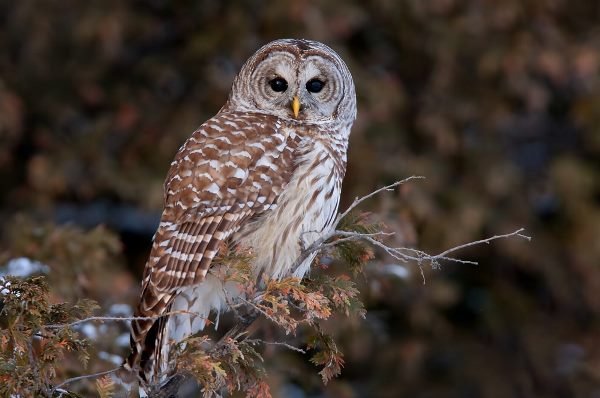
- Scientific name: Strix varia
- Size: 17-20 inches long
- Weight: 16.6-37 ounces
- Wingspan: 39-43 inches
The barred owl is similar in length to the great horned owl, but they weigh much less. They are mottled brown and white with distinct bars across their entire body. The bars on the breasts are vertical and horizontal on the rest of their bodies.
These aren’t noisy birds. They generally keep quiet, though you can sometimes hear them call out during the day.
Barred owls stick to forested areas, whether that’s the swamp or high up a mountain. You won’t find them in cities or prairies. They live across the entire eastern US and up into Canada. In recent decades, the birds have expanded their range, and now there are also populations in the Pacific Northwest. They don’t migrate during their lives. They stick to one place, making their home in trees. However, if they can’t find food, they will travel long distances to hunt.
Great horned owls hunt the barred owl, while the barred owl is pushing the endangered spotted owl out of its territory.
Barred owls live in the eastern part of Texas all year long.
5. Short-Eared Owl

- Scientific name: Asio flammeus
- Size: 13.4-17 inches long
- Weight: 7.3-16.9 ounces
- Wingspan: 33.5-40.5 inches
You’re right if you guessed that these owls have short ear tufts. Owls have ear tufts to help direct sound to their ears, enabling them to hunt and hear potential predators. Short-eared owls have ear tufts, but they’re small, like little horns.
They’re distinctive owls because they have brown and white mottling edged in black bars. The face is cream with dark black outlines around the yellow eyes.
Their distinctive appearance makes it easier to spot them, but the fact that they are active during the day makes it even easier to see them. They even have a distinct, moth-like flight pattern that makes identification even simpler.
Unlike many owls, they don’t prefer wooded areas. They like open fields and grasslands, where they sit on the ground and watch and listen for prey to catch. Then, they fly up and dive down to catch their prey. They even nest in the ground.
Short-eared owls live in all parts of Texas during the nonbreeding season.
6. Northern Saw-Whet Owl

- Scientific name: Aegolius acadicus
- Size: 7.1-8.3 inches long
- Weight: 2.5-5.3 ounces
- Wingspan: 16.5-19 inches
Northern saw-whet owls are petite, about the size of a robin, with a mottled brown and white body. They have big yellow eyes and a heart-shaped face with a small, white V-mark between their eyes.
They are difficult to see, especially because they hunt at night, but if you listen for their shrill call, you’ll know they’re nearby. During the day, they nest in cavities in trees at about eye height, so you might see them if you look carefully. Don’t disturb the sleeping birds, though!
They only live in forests, particularly mature forests, so don’t look for them in open areas or cities. They migrate long distances to breed. They eat small rodents like mice and shrews. They’ll also eat birds like chickadees, juncos, waxwings, and sparrows.
They live across the US, with scarce breeding populations in the South and permanent populations in the northern part of the country and throughout the Rocky Mountains and western Coastal ranges. Nonbreeding populations exist across the rest of the country.
The northern saw-whet owl lives in a small section of the western edge of Texas year-round and the rest of the state only rarely during the nonbreeding season.
7. Burrowing Owl
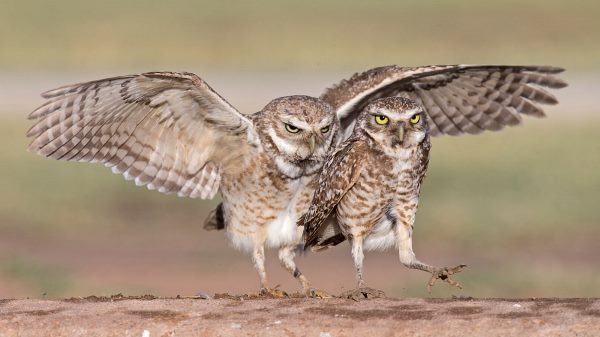
- Scientific name: Athene cunicularia
- Size: 7.5-9.8inches long
- Weight: 5.3 ounces
- Wingspan: 21.5 inches
Most owls live in the trees or shrubs, but burrowing owls have long legs to run along the ground in prairies, deserts, and grasslands. They hunt for rodents and then live in tunnels that animals have abandoned, like ground squirrels and prairie dogs.
They’ll even hunt small rodents and then take over their burrows. If that’s not available, they’ll live in pipes or tubing.
They’ve adapted to life underground by developing a high tolerance for carbon dioxide, which builds up in underground spaces.
Look for long-legged owls with mottled brown coloring and bright yellow eyes to identify them. They have flat heads.
Burrowing owls live in most of Texas all year long, but they live in the northern panhandle only during the summer.
8. Long-Eared Owl
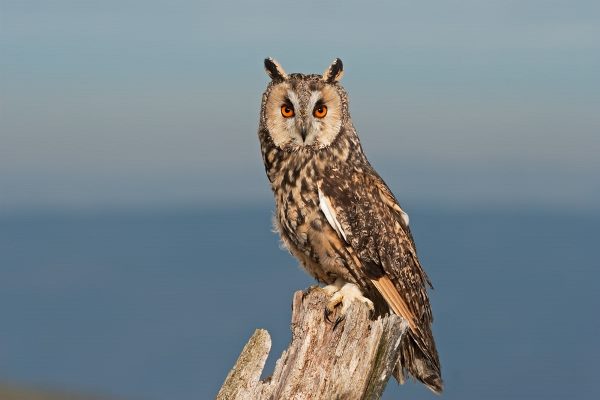
- Scientific name: Asio otus
- Size: 13.8-15.8 inches long
- Weight: 7.8-15.3 ounces
- Wingspan: 35.5-39.5 inches
Long-eared owls have surprisingly long ear tufts, which is how they got their name. The tufts are black with bits of buff or orange. They have two white lines between their yellow eyes.
They’re slender with mottled brown bodies. These nocturnal birds roots in trees and hunt in grasslands or open country.
You can often identify them by their hoots, squeals, and barks. They are quite vocal. They usually only migrate at night, but they can fly exceptionally long distances. Researchers have identified birds that have traveled from Canada to Mexico in a single year.
Those who live in or are visiting Texas should look for this owl all year-round in the western part of the state and in the eastern half during the nonbreeding time, though you’ll only see them scarcely.
9. Eastern Screech Owl

- Scientific name: Megascops asio
- Size: 6.3-9.8 inches long
- Weight: 4.3-8.6 ounces
- Wingspan: 18.9-24.0 inches
The eastern screech owl is related to the western screech owl, as you might expect. This owl lives on the east side of the Rocky Mountains, with a little overlap in the Rocky Mountains between their western cousin.
In Texas, you can find them across the state all year long, except for the very western strip of the state. The birds don’t live there at all.
Eastern screech owls are excellent hiders. Their gray or reddish-brown mottling makes them blend right into the bark of the trees where they like to perch and nest. In fact, you might not even notice them until you see their bright yellow eyes shining.
They have distinct ear tufts and a yellow beak, with a dark V between their eyes.
These owls are night hunters, which makes them even more of a challenge to see. Your best bet is to listen for the whining trill call that they make and then keep your eyes peeled. If you’re not big on bird-watching at night, look at the cavities of trees as you walk around their native range. You should be able to see them as they sleep the day away.
10. Western Screech Owl
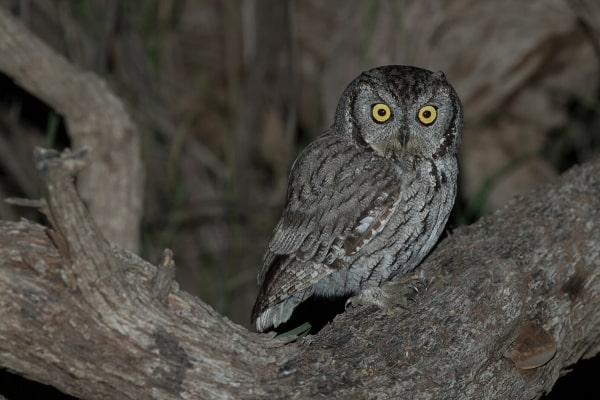
- Scientific name: Otus kennicottii
- Size: 7.5-10 inches long
- Weight: 3.5-11 ounces
- Wingspan: 21.5-24.5 inches
Western screech owls are small, about the size of a robin. But the screech they emit is anything but petite. They’re hard to spot in the wild because they blend in super well with their environment. If you want to find a screech owl, sit outside at night and listen patiently.
The base of their body is gray, brown, or red, with a pale breast. Their body is covered in dark streaks that look incredibly similar to the bark of many trees. They have yellow eyes and distinct ear tufts in a V-shape.
They’re nocturnal, and they make their home in the holes of trees and cacti, but they’ll also make their home in a nestbox in your backyard if you provide them with one. They’re common in suburban areas, and they’ll even make their home in urban parks. In Texas, these owls only live on the western edge of the state and in a tiny spot in the center.
While they prefer to eat small rodents, they’re powerful birds and can even pick up a full-grown rabbit.
11. Flammulated Owl
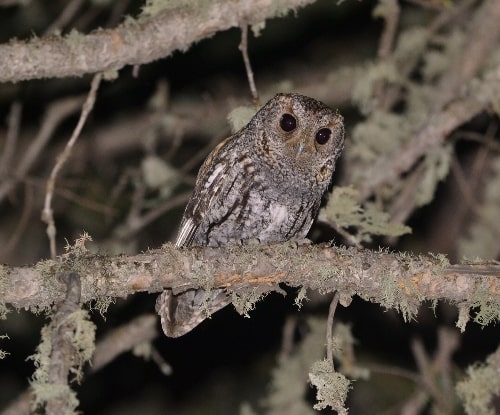
- Scientific name: Psiloscops flammeolus
- Size: 5.9-6.7inches long
- Weight: 1.5-2.2 ounces
- Wingspan: 15.9-16.1 inches
The Flammulated owl is tiny. It’s barely larger than a sparrow. These are night-hunting owls that roost in trees during the day. At night, they swoop out to spot their insect prey and devour it.
They live in coniferous forests in the western part of the US. You can find them in the western strip of the state when they migrate through. Otherwise, they spend their time year-round in Mexico.
For such a tiny bird, you might mistake them for something much, much larger if you were to only hear their call. They have a deep, booming hoot that makes them sound large. This helps them scare away other predators.
Look for a tiny owl with feathered ear tufts and vertical stripes on the belly. They have dark eyes and a grayish back.
12. Barn Owl

- Scientific name: Tyto alba
- Size: 12.5-16 inches long
- Weight: 14-24.7 ounces
- Wingspan: 40-50 inches
The barn owl got its name because it likes to live in abandoned barns and other buildings in rural areas. They’ll also nest in the cavities of trees. They hunt by soaring across open areas and listening for prey. As you might guess, they have excellent hearing.
You can tell it’s a barn owl by its distinct face. They have pure white, heart-shaped faces with large, dark eyes. Their wings and back are gray, golden, or cinnamon and somewhat mottled. The undersides of their wings are white, as is their chest, which means they look all-white from underneath when they’re flying. They don’t have any ear tufts as the great horned owl does.
Young barn owls will fly far away from where they were hatched to find their own territory, but once they find a spot they like, they stay there for life.
You can find barn owls across the US and Mexico except in a few parts of the central northern states like North Dakota. The owl lives in nearly every part of Texas, so your chances of seeing them are good.
13. Spotted Owl

- Scientific name: Strix occidentalis
- Size: 18.5-19 inches long
- Weight: 17.6-24.7 ounces
- Wingspan: 40 inches
As the name suggests, spotted owls have white spots, but they look dark brown overall. You’ll see more white spotting on the chest and less on the back and wings. They have distinct dark brown facial disks with a white “X” between the brown eyes.
These nocturnal birds hunt for small mammals like rats and squirrels. They’re silent hunters, and once they find their prey, they fly down and snatch them up. They live and hunt in mature forests, but since many are being cut down, the spotted owl population is in decline.
This bird is federally protected, but logging, habitat loss, and competition from Barred Owls are driving down populations.
Count yourself lucky if you’re able to spot one. They’re rare. Go out at night and listen for their hooting to have a chance at finding one.
There are three subspecies, which include the Northern Spotted Owl, the California Spotted Owl, and the Mexican Spotted Owl. In Texas, you’ll see the Mexican Spotted Owl in small flocks near the western border.
Also Read: Woodpeckers in Texas
